-
United States -
United Kingdom -
India -
France -
Deutschland -
Italia -
日本 -
대한민국 -
中国 -
台灣
-
-
產品系列
查看所有產品Ansys致力於為當今的學生打下成功的基礎,通過向學生提供免費的模擬工程軟體。
-
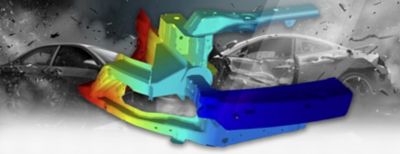
將安全設計到車輛中不僅是好的商業行為或法規要求。對於汽車產業來說,安全是一項道德責任。意外會發生,而當意外發生時,車輛設計可以決定司機、乘客和行人的生死。更安全的設計還可以減輕車禍為個人、醫療系統和社會帶來的經濟負擔。
本質上,關鍵就在於產業能否使每輛車都盡可能安全。
雖然「不惜任何代價確保安全」是一個理想,但汽車工程師面臨著相反的壓力,主要體現在縮短的開發時間表和預算限制上。因此,工程師可能會被迫優先考慮被認為可以降低事故嚴重性的安全層面,或尋求更具成本效益的策略,例如分段實施安全功能。
電腦輔助工程 (CAE) 已成為車輛設計流程的重要一環,可平衡安全性與上市時間。虛擬分析可讓設計師可靠地評估車輛的碰撞與安全效能,同時減少成本高昂的實體測試。
Ansys 應用工程師最近使用 Ansys SimAI 雲端生成式人工智慧 (AI) 平台,快速預測汽車保險桿在高速正面碰撞時的變形情況。
他們的工作結果顯示,軟體經實證可有效預測流體移動方式,特別是由計算流體動力學 (CFD) 求解器模擬持續動作,也可以處理其他物理學,例如非線性、暫態結構模擬。
準確度和速度
隨著車輛越來越複雜,其設計中使用的數位模型也變得越來越複雜。模型的規模也更甚以往,需要更多運算資源,也大幅延長模擬時間。
如今,具有 4,000 萬到 5,000 萬個元素的全車模型並不少見,當代高效能電腦叢集 (700 到 1,000 個 CPU) 需花費 25 到 30 個小時來解決一個完整的碰撞事件。這個結果還是基於工程師已經投入數個月的時間清理新的電腦輔助設計 (CAD),移除在重用來自舊程式零件和子系統 (早期概念階段的常見做法) 後仍存在的交集 (重疊) 和穿透 (間隙),並且將 CAD 網格化、添加所有必要的連接和材料、除去任何錯誤,以及建立基準效能。
即便如此,CAE 模型經常無法跟上所有的設計變更,除非工程師已明確定義這些變更,並針對變更的模型各主要層面建立參數。由於參數化困難且耗時,複雜的設計變動更是如此,因此僅有少數設計經過徹底評估。
這就是 SimAI 平台能發揮強大能力的地方。
SimAI 產品透過結合 Ansys 模擬的預測準確度與生成式 AI 的速度,能在幾分鐘內預測全新設計的完整 3D 回應。對於運算密集的複雜專案,SimAI 預測輸出內容的速度能比有限元素求解器快 10 倍至 100 倍。
加快模擬過程能夠促進更多的設計探索,讓汽車工程師能夠嘗試更多的想法和創新,並在過程中更早地專注於有前景的設計。
訓練日
SimAI 技術是不受物理限制的雲端式軟體,可經過訓練,與流體、結構、電磁學等多種領域搭配使用。
為了展示它如何能夠預測像汽車碰撞這樣的瞬態事件,當一切都在快速且不斷變化時,Ansys 應用工程師以一個「滑雪板」為起點,即簡化的 Ansys LS-DYNA 結構模擬軟體車輛模型。在此情況下,滑雪板會模擬保險桿以每秒 15.6 公尺 (16.4 碼) 的速度撞擊剛性壁面。
為了產生足夠的資料點以準確預測瞬態回應,Ansys 工程師引入設計變異。在上下限範圍內變更七個零件的厚度,產生 98 種不同的設計,每種都有 21 種狀態:碎裂、彎曲、折疊等,總計 2,058 個訓練資料點。
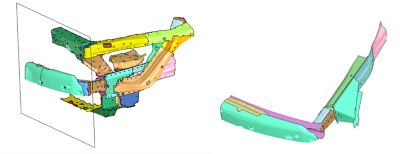
保險桿擠壓模型。醒目顯示的零件厚度會改變。
接著,Ansys 工程師將資料上傳至 SimAI 平台,自動分類為訓練、驗證和測試集。驗證集讓工程師能夠微調模型的基礎結構以改善效能,而測試集則可判斷模型處理不熟悉情況時的表現。
接下來是設定模型,包括決定:
- 邊界 (或撞擊) 條件。
- 輸入,在此案例下為撞擊期間內的不同時間點和多個零件的厚度。
- 輸出,剛性壁力 (或壁所承受的力) 和節點位移 (保險桿上標示點上下移動或左右移動的程度)。
- 精準度,會直接影響模型訓練所需的時間。「精準」模型需要長達兩天的訓練時間,而「非常精準」模型通常需要一週。在這個案例下,模型需要大約 21 小時的訓練時間。
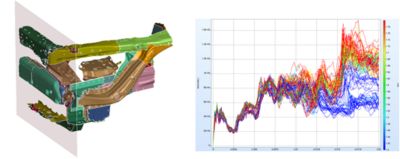
保險桿變形狀態和剛性壁時程圖
Ansys 工程師比較 SimAI 軟體計算撞擊期間對牆面施力的結果,與傳統求解器的計算結果,來評估 SimAI 軟體的準確度。
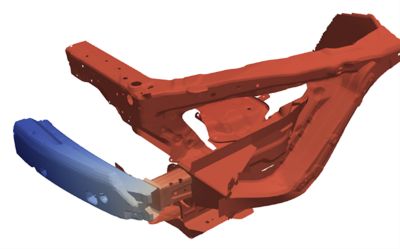
具有節點位移場的樣本 .vtp 檔案。幾何以 .vtp 或 .vtu 檔案格式寫出;.vtp 儲存表面 (殼元素) 資料,而 .vtu 儲存體積 (實體元素) 資料。
結果比較
繪製求解器和 SimAI 產品所做的預測可發現些微差異。雖然兩者都在相同的時間步長預測保險桿的形狀和壁力,但點位並不完全一致。AI 的假設點並沒有完全落在圖表上與求解器相同的斜直線。
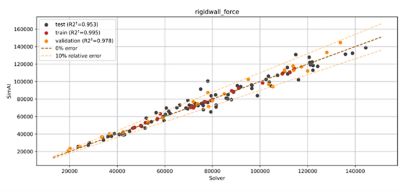
Ansys SimAI 雲端生成式人工智慧 (AI) 平台全域係數剛性壁力 (rigidwall_force) 趨勢圖
這其實是件好事。
完全一致並非永遠是最佳結果,反而可能表示 AI 與訓練資料過度擬合,AI 可能只是記住用來訓練的特定範例,而非基本規則。過度擬合的 AI 將無法完美預測以前沒有見過的全新設計。
然而,由於 SimAI 軟體的預測大部分與求解器的預測相符,這表示 SimAI 模型的預測準確,沒有過度擬合。該圖還顯示 AI 訓練可以改進的區域,以獲得更好的結果。

求解器與 SimAI 平台的變形形狀比較
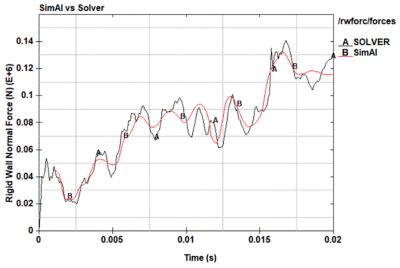
求解器與 SimAI 平台的剛性壁力 (rigidwall_force) 預測比較
安全,更快速
最後,SimAI 技術的速度經證實比傳統求解器快幾個數量級,在不到一秒便預測了牆上的力,約 10 秒內就預測了整個保險桿的運動。
然而,速度並不是 SimAI 優於傳統模擬的唯一優勢。SimAI 解決方案可以預測碰撞過程中的每個點會發生什麼 (在訓練資料的限制內),因此提供了更詳細的保險桿變形情況,包括中間狀態,而不僅是結果。
這代表汽車工程師可以為瞬間、非線性事件提供準確的單一模型,進而加快汽車上市時間,並減少開發預算負擔。
下載完整白皮書「Ansys SimAI 軟體完整預測瞬態車輛碰撞結果」,並進一步瞭解 SimAI 平台。













